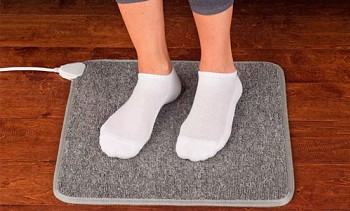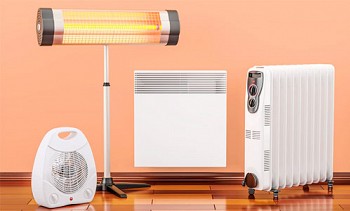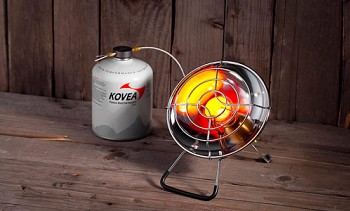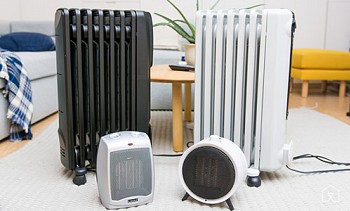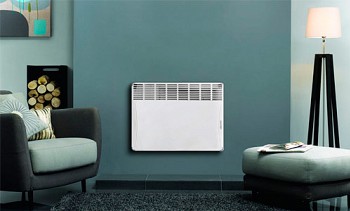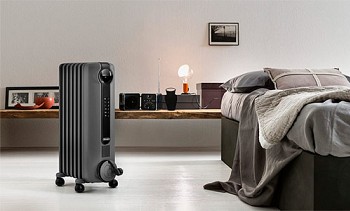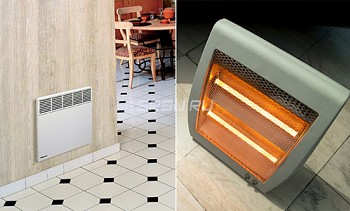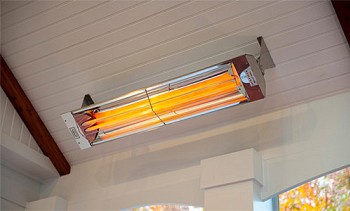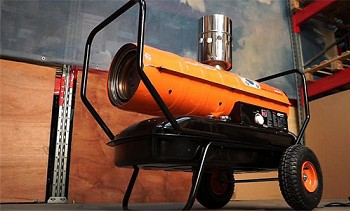Among heating appliances, a separate niche is occupied by infrared heaters, which are gaining more and more popularity. When deciding whether such an apparatus is suitable for specific operating conditions, it is worth considering its varieties and principle of operation, as well as taking into account all the pros and cons of infrared heaters so that the choice is correct, and the result meets expectations.
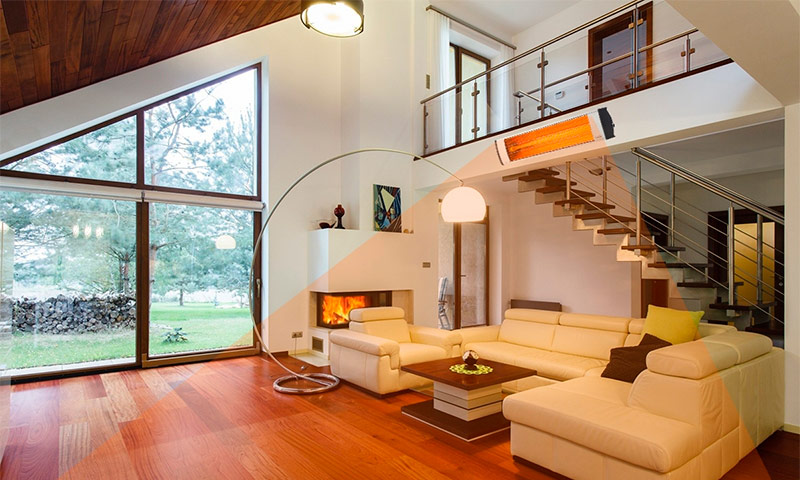
Content:
Features of various types of infrared heaters
The result of the IR heater is similar to the effect of the sun. Radiant heat immediately warms a person, bypassing the air, which increases the efficiency of the device. Gradually, the walls and objects heat up, which also begin to reflect heat. According to the type of energy carrier, all infrared heaters are divided into electric, gas and liquid fuel. For heating domestic premises use electric and gas infrared heaters. At the same time, gas is used much less frequently.
Electric IR heaters
Electric infrared heaters can be divided into light and dark. Light or short-wave infrared heaters as a heating element have glass tubes with spirals enclosed inward. They are able to heat up to temperatures over 600 C and emit quite bright light. These devices produce very intense heating in the direction where their heating elements are facing.

Dark or long-wave infrared heaters have an operating temperature of less than 600 C and are available as fuel panels and films. Most often, such heaters have an operating temperature of 300 C to 400 C. This allows such devices to be hung on a wall or ceiling. IR heaters of this type are not able to overheat the human body, they can be turned on for a long time.

The principle of operation of an electric infrared heater is to supply voltage to the heating element, where, thanks to the internal structure, thermal energy is converted into electromagnetic waves emitted in the infrared range, and a metal reflector facilitates their propagation in the room. In the case of thin plates (wall mounted models), heat spreads over short distances.
A person feels infrared rays in the range from 5.6 to 100 microns, starting from which they produce heaters with short (2-4 m), medium (3-6 m) and long (6-12 m) effects. Depending on this, heaters are used both in ordinary houses and apartments, and in production for heating workshops and hangars.
Electric infrared heaters are available in vertical and horizontal housings. By the type of installation, they are floor-low, floor with a high rack, wall and ceiling. The equipment is effective both indoors and outdoors.
Gas IR heaters
The principle of operation of a gas infrared heater is similar in its final result to an electric one - radiant heat in the infrared range is also released here. But to create it, a ceramic plate is used. It is heated by the supply of natural gas and air, combining in a mixing chamber where flameless combustion takes place. As a result, the main heat is given to the porous ceramic plate. Heated ceramics begin to give off infrared rays into the room.
This type of equipment is more mobile, because it works from a cylinder. The latter is installed side by side or can be diverted from the device thanks to a long hose. The design of some heaters allows you to hide the cylinder inside the case.

The shape and type of gas infrared heaters are:
- household (house, cottage);
- Camping (for tents);
- on a high rack (for street cafes, viewing platforms).
Now, understanding the principle of operation of the main types of this equipment, let's look at the advantages and disadvantages of infrared heaters relative to oil or convection. This will help to make a competent choice for heating an apartment, house, open area or workplace.
Given the low prevalence and a slightly different principle of operation of gas models, we omit their comparison and focus on electric heaters.
Pros of infrared heaters
A clear advantage of infrared heaters is the simple design and low price compared to oil and convection, which have a greater number of internal parts. But there are other advantages.
Direct heating
In other types of heaters, a two-stage heating system is used: first, the device heats the air, and walls and people heat up from increased room temperature. Therefore, spending a certain power, the equipment transfers less heat to the end user.
In infrared heaters, thermal radiation acts directly on the user, bypassing the air. Of course, the latter also gradually heats up, but this comes from warm walls and objects. Therefore, the expended electrical energy is completely given up to the heat received by a person.


High heating rate
In order for a person to feel warm from the switched on oil cooler, it should take about 30 minutes. Time is spent heating electric oil, then air in the room, and only then the user.
For convection models, this happens a little faster, but the process is still complicated by the fact that the warm air heated from the panel rises, and the person, remaining lower, continues to experience discomfort. And only when the entire air volume is heated and mixed, then you can warm up.
Infrared heaters begin to give off heat immediately after the spiral is heated, which takes 27 seconds. Already after this time, thermal rays shine on the user, warming him. Arriving from work, you do not need to sit for a long time in a cold room, but you can immediately create a comfortable mini-climate.
Cost-effectiveness
Since IR heaters do not need to heat the entire room, they can be used with a lower power level compared to other types. For example, for oil, the optimum is 1500-2000 watts to warm a large bedroom. It is enough for an infrared device to consume 500 watts, being aimed at the consumer. Even with this simple example, it can be seen that power consumption is reduced by 30-75% depending on the settings and the distance from the user.
Lack of convection air flows
According to the law of physics, warm air from other types of heaters always rises up, and the lower the person is, the colder.

Directed heat from an infrared heater falls to a specific location, regardless of height. IR rays do not propagate from bottom to top, but along a given vector, being directed by a reflector.
When convector heaters are working, constant mixing of air masses is observed. Such a movement creates drafts and promotes the earliest possible weathering of the products left in the room and the movement of dust. Infrared heaters do not cause air movement, which provides pleasant conditions.
Local heating
When the room is large, infrared heaters are practical in that they allow local heating to be carried out, maintaining an elevated temperature in only one part of the room. For example, in a large office it may be a zone with employees sitting at desks, while the side of the room with a file cabinet will remain cooler. In the warehouse, you can warm the area with the delivery of goods, where people directly rotate, and leave the shelves with a lower temperature.
Silent operation
In IR heaters there are no fans, oil drilling, other moving parts.It is set to a certain level of heating, after which the device is turned off. Of all the sounds made, only periodic relay clanging is heard, which can be eliminated by setting the heater to maximum (so that it does not turn off), and limiting the heater's power by the toggle switch (so as not to overheat). Such a silent option is optimal for the bedroom and children's room, and does not interfere with the rest sounds with unnecessary sounds.
The possibility of heating in open spaces
If you install an oil cooler on the street, then its heat will evaporate upwards, and with a slight breeze it will cease to be felt even at a short distance. IR heaters are exposed to infrared radiation that passes through the wind and drafts, while continuing to warm people and objects. This allows you to use them on verandas without glazed windows, in gazebos, terraces, street cafes, VIP-zones on sports grounds, open workplaces.

This is especially advantageous in cases where ventilation and heat storage are simply necessary at the same time. For example, during welding or during painting, it is allowed to open all the windows and doors in the room, but the device will invariably continue its warming effect.
Long service life
In infrared heaters there is only a heating element, a power regulator and a reflector (the latter is not in all models, but only in high-temperature ones). Moving parts and coolant circulation are completely absent. In fact, there is nothing to break, and maintenance requires only periodically wiping the reflector, for more efficient heat distribution. Simple and robust design withstands accidental shock or fall.
Environmental friendliness
The heating elements are closed with glass tubes, so sometimes (after a long period of inactivity) you can feel only a slight smell of burnt dust, which quickly passes. During operation, no by-products are emitted (combustion of carbon, smoke).
In their design there are no harmful materials (only steel, glass, ceramics, dielectrics and PVC, in the places of the body not subject to heat), so during operation no toxins or poisons evaporate. Heat acts gently, like sunlight, and does not affect sleep or the phase of active life. In the event of a breakdown, oil contaminating the floor does not leak from them.
Wide installation options
Unlike other types of heaters, IR devices can be installed at different angles with respect to the user and in all spatial positions.
It can be done:
- from the floor, pointing the luminous panel up at the seated person;
- to fix the device on the wall - it will warm sideways or from above;
- hang on the ceiling, pointing down.

High mobility and unpretentiousness to the place of operation (for example, for models on a high rack with adjustable position) allow you to use one device in different conditions, without buying in return several others (wall and ceiling).
Cons of infrared heaters
Despite all the advantages of infrared heaters, compared with oil or convection, this type of equipment still has disadvantages. They are insignificant, but they should be taken into account when choosing a heating device for an office, house or apartment, as this will affect the ease of use and safety.
Rapid temperature reduction when the heater is turned off
If you turn off the oil heater, then from the heated liquid the heat will still spread for some time around the room. This allows you to alternate the intervals of activity and passivity of the device so that it consumes less electricity, but does not stop warming.
Infrared heaters give off heat only when turned on. As soon as the voltage ceases to flow to the heater, radiant heat ceases. The user immediately becomes cool. If the device has been working in the room for a long time, so that the walls and objects have warmed up, then the comfortable temperature will last a little longer.When turned on for a short time, as soon as the device is turned off, it will immediately become cold.
Uneven heating
Another disadvantage of an infrared heater is uneven heating. All his work, due to the involvement of electromagnetic waves in the infrared range, has a directed action. As a result, in a room with an area of 5x5 m, those people who are in the zone of influence of the heater will feel the heat. The rest will be cool. For example, if there are two beds in different angles in a children's room, you will have to put them next to each other or use two infrared devices at once.

Uneven heating is manifested in the fact that radiant heat heats the area like light from a flashlight - where it gets. Therefore, on the one hand, the human body can even be hot, and on the other hand you feel cool from the surrounding air. With such an operation of the device in the open air, it will have to be periodically rearranged or rotated by itself to keep warm from all sides.
Adverse effects on humans through prolonged exposure
In general, infrared heaters are safe for health, but problems can occur if you are under a high-temperature device that is constantly on. It’s the same as sitting in the sun for a long time - you won’t be able to tan from infrared rays, but concentrated heat will dry the skin, and the body will not have time to compensate for the loss of moisture by removing sweat in this place. Overdried skin can then bake and peel off. Therefore, it is not recommended to sit on one side with bare parts of the body to a constantly switched on heater.
Danger for children and pets
High-temperature IR heaters with spiral heating elements can cause burns if a person touches the bulb or reflector. Although the heater of the IR heater is enclosed in a glass tube, the surface of the latter is still very hot.
The heater’s heater is often closed with a metal grid with large cells, so children, out of curiosity, can easily put their hand in there. In view of this, do not leave the infrared heater on and children in the same room unattended. A pet with long hair may suffer if it is rubbed against a heater and accidentally touches a heated bulb with a spiral.
Bright light
Infrared heaters with tubular heating elements have another drawback - a bright glow. In daylight, it catches the eye a little and only helps to see if the device is working or not. In a street cafe setting, this is even attractive in the evening.

But in a room at night such a “light bulb” can interfere with rest, continuing to shine brightly in the eyes. It is impossible to turn the case in the other direction, since then the heat will be directed past.
Fire hazard
This disadvantage again applies only to high-temperature models. The high rack of the heater allows you to install it at different levels to adjust the direction of radiant heat depending on the user's location. The stand has a stand with four points of support, providing a stable position, but a large dog in the house can easily fill up the device by running past. If this is not seen, then touching the carpet or continuing to shine on the wooden floor in this position, the heater may cause a fire.
Having examined the topic of the pros and cons of infrared heaters from all sides, it will be easier for you to make your choice. And to find out already tested and popular models that have positive reviews, you can look at the next page of the site, which describes the best infrared heaters of all kinds.

